X
HGG Community Forums
Log In to HorseGeneticsGame
HGG Community Forums
Join our discord server!
Howdy, Stranger!
It looks like you're new here. If you want to get involved, click one of these buttons!
Categories
- All Discussions68,241
- Announcements356
- HJ2 Discussion67,060
- ↳ New Member Introductions569
- ↳ Help me out3,469
- ↳ Horses For Sale and Auction12,515
- ↳ Breeding Ads and Sales3,456
- ↳ Herd Helper39,570
- ↳ Bug Discussion120
- ↳ Repair Log12
- General Discussion825
- ↳ Saddle Sisterhood32
- ↳ Games, Contests and GiveAWays54
- ↳ Genetics245
In this Discussion
- Ammit January 2017
- best friend January 2017
- Cheers January 2017
- Denalidom January 2017
- KerredansCorral January 2017
- ObsidianKitsune January 2017
- Ritsika January 2017
- Salvistar January 2017
- SandycreekFarm January 2017
Who's Online (0)
White Factor?
-
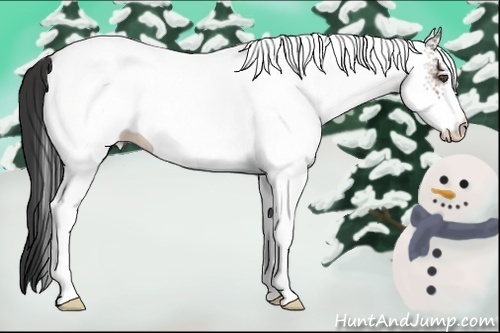
Iced Leaves AWn2
I am going to use him for my 2g mares next season. His wf is large. So my question is 6 of my mares in pasture also have a large white factor. Would they be safe or should I take them out and see if any of my other mares have none to medium white factor to put in the pasture for him? -
It depends on what Kit genes your other mares have. It would help to post a link to the mares.SALVISTAR PERFORMANCE HORSES
Barn ID - 2358 -
If the kit cross isn't safe, I wouldn't do it. Here's a link to hopefully explain it all.
http://hj2.huntandjump.com/forum/discussion/13757/new-kit-lethality-and-kit-mutation-load-explained#Item_11
This stallion has two kit genes (w2 and w20). The w20 is mostly alright, but the w2 will end up being the problem, I believe.Producer of Volcanic Glass Drafts. Lapisobsidianus.
Prices are almost always negotiable. -
-
It's not loading for me. I take it since he is a warmblood it'll be the pasture with most wambloods in it, so primary?
http://hj2.huntandjump.com/pub_member.php?u_id=14374&p_id=0&past=yProducer of Volcanic Glass Drafts. Lapisobsidianus.
Prices are almost always negotiable. -
Had a look and these are all the horses with a kit other than roan or tobiano.
http://hj2.huntandjump.com/horse.php?horseid=548901
kitw2kitw20
http://hj2.huntandjump.com/horse.php?horseid=522165
kitw2kit
http://hj2.huntandjump.com/horse.php?horseid=533458
kitw20kitw
http://hj2.huntandjump.com/horse.php?horseid=542932
kitw2kit
http://hj2.huntandjump.com/horse.php?horseid=548234
kitkitw20
Producer of Volcanic Glass Drafts. Lapisobsidianus.
Prices are almost always negotiable. -
Yes those are the mares. I dont fully get the wf. Or the genes that make it. Not sure if that makes sense.
-
I would not breed him to any mare that has w20. From what I have found out , it seems to kick up the white factor. If you look at his sire, his White Factor is none, and having W2 he doesn't show a lot of white. He got the w20 from his Dam, and she had a medium white factor, even though looking at her she doesn't show as much white on her as his sire. I think you would be better off breeding him to mares that have no kit genes at all, and letting him be the one to give it to the offspring.
-
Ok then i may have to buy some in a few days. I think my 2g mares all have some sort of wf.
-
White factor doesn't matter when you're talking strictly crosses that are potentially lethal. White factor increases the chance that a potentially lethal cross is lethal. W2 is potentially lethal with anything except roam and tobiano. Outside of those you're taking a (sometimes low, sometimes risky) chance.
-
Most of my mares have either W20 or W2.
-
I'd cross him on w20 mares myself, since it's such a small risk. Crossing him on a w2 mare - especially one with high white factor - is pretty risky. I'm in a similar position with my KP line, and I just keep multiple stallions so I don't have to chance losing a bunch of foals.
-
I agree with Denalidom. I would cross him with mares that have W20 but I would avoid breeding him to mares with W2 because the risk is moderate.
I think of the white factor (WF) as a radar for determining how "broken" the genes are. If the white factor is high or extensive, you will notice that the majority of the horse is white especially with the white spotting mutations like W and W2.
I have been experimenting with the KIT genes because I love my KP line and, like Denalidom, I simply keep numerous stallions to have ideal crosses with mares. At the start, I didn't keep colts with high risk (lethal) genes but, now that I've grown my mare herd, I do because I have "plain" mares to breed them to. It is all about the long game and deciding what genes you want to have in your herd then deciding how to introduce them into your stock. :) -
I like all genes really. I know I want to be real careful not to produce a lethal white. I am still having a hard time figuring out tje differences between the Kitw kitw2 kitw20. I dont think I have any w10 intact horses.
How do I figure these genes out better? -
@best friend, it all takes a lot of practice. I would suggest going to the "search horses" engine and selecting the "pattern" tab then search horses with Kitw and Kitw2. Separately, of course, so that you can begin to identify each pattern.
From what I understand, W20 works as a booster and is safe with most patterns. If the horse doesn't have another pattern to boost, you don't see much change. If a horse does have a pattern, such as W2, then W20 will work to expand the expression of the gene thus more white on the horse. -
Horse search, Patterns Tab, under Kit, pick Must Have one of the 3, pick Must Not Have the other two, search. Repeat with the other two genes. It will only show you color tested horses, so you will see the gene you are looking at, the white factor and any other patterns (Kit or not) and how they all interact. Horse Search is a huge resource for learning about the specific genes, what they look like and how they interact.
-
Alright thanks guys gonna go study that now.
-
Ok went to the genetics guide and all i am getting is pictures. I am wanting to read up on the different kit genes. I need a better understanding.
Kitr is roan.
Kitto is tobiano
It is the rest of them that has me puzzled.
I know chromemisone 3 is responsible for the kit genes.
I think the rest of them is how the white spotting interacts with the hairs. I dont understand the differences between them.
I did do some horse searches on them to. I am not seeing how they work. -
@best friend, I did not realize you meant to learn about the nomenclature and the scientific means of the occurrence. I am not 100% certain I can help, but I would suggest investigating the USDavis Veterinary Medicine website. They produce quite a few scientific articles regarding white spotting mutations and dominant white, and I believe they are reputable.
Otherwise a good old search on google is great, too! As far as I understand it, Kitw on HJ2 is dominant white and Kitw2 is another dominant white variant. Though, in the scientific community, I think they are adopting the term white spotting because not all of the Kit mutations follow autosomal dominant inheritance thus the confusing name of "dominant" white that isn't genetically dominant. From my understanding, a lot of the number that goes behind the "W" is to simply keep track of the individual mutations that have been identified to keep them separate because some white patterns that look the same are not across the breeds: for example, I believe W3 is a white spotting that occurs in Arabians. But I'm babbling now, it is late for me and I should be in bed, so back on topic I would suggest wikipedia to start your search and delving further to find more trustworthy, accurate sources of information. By googling you can definitely identify which white spotting is which, what breed has the mutation, and how the mutation interacts at the molecular level to produce the phenotype most associated with the mutation.
As for the horse search engine on HJ2, I would suggest taking a break and coming back to it later. Sometimes when we look the hardest we don't see it even thought it is right in front of us. I have noticed a trend that the white spotting mutations and the dominant white patterns often correlate with high white factor while the other Kit mutations can have a range of none - extensive white factor depending on other genes such as splash and frame. It is all about variables from sire and dam + a little bit of random, I don't know how foals are generated so the random might not be so random. -
I found what I was looking for. The lethallity chart. I really want to know how to recognize the kit genes before I test. Tomorrow got to look at it and the mares. Thanks everyone for helping me tonight.
-
It's white spotting in the game too.
___________
Need to contact me? Read this first.
http://www.huntandjump.com/forum/discussion/3/how-to-get-help-from-an-administratorThanked by 1Ritsika -
@Ammit I know it is white spotting. I am wanting to know how the different white spotting genes work. Or is it just the white spots how they work on the base coat.
-
What makes the horses either none to extensive? Not sure if I am asking the right question.
-
With practice you can begin to identify most of the Kit White variations on sight because each has a fairly distinctive pattern of white spotting. Some are a bit similar. In these examples I have tried to choose horses that don't have a lot of splash or other genes that cause white.
Kit W1 Minimal White Factor
G Masquerade Creek
Kit W2 Minimal White Factor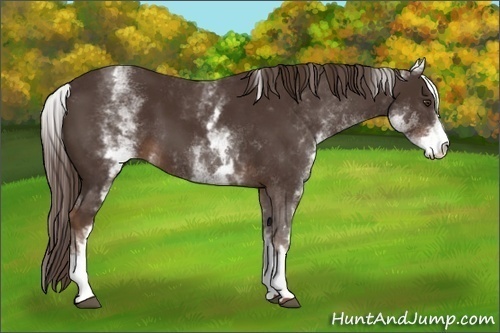
2TT Lady Flame
Kit W3 Medium White Factor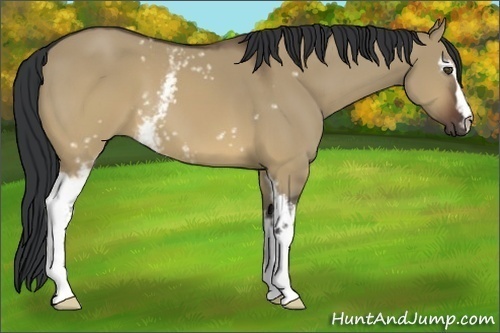
Sahara Mystery
Kit Wm Medium White Factor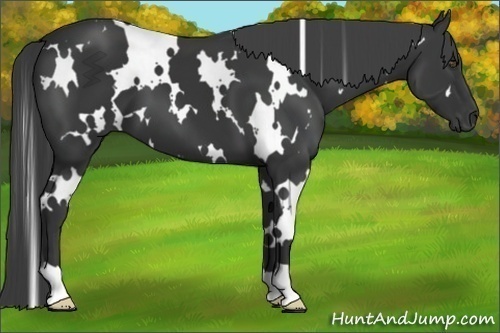
Shining Loud
Kit W8 Medium White Factor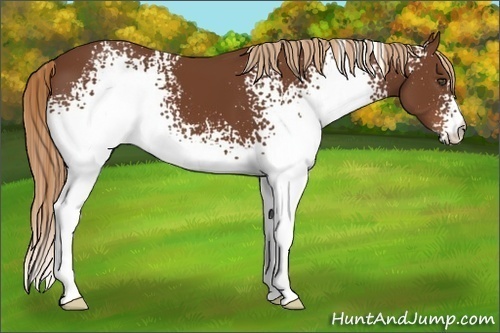
Y27 2 286462
Kit W10 Medium White Factor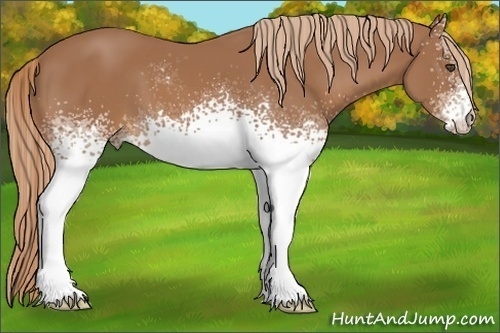
EE SSF G2 6De gustibus non disputandum. "There's no arguing about tastes."
SandyCreek Farm: ID# 441
also playing H&J1 as SandyCreek Acres: ID# 137592 -
So w10 and w1 look very similar. I am wondering if I am right there right factor is from the belly down?
-
White factor controls the amount of white on a horse. A higher white factor leads to more white.
So a plain bay with large white factor might have a big blaze and tall socks while a plain bay with no white factor might have tiny socks and a star.
A horse with Kitw and high white factor might look completely white while a horse with kitw and low white factor might have just white on its legs belly and muzzle.SALVISTAR PERFORMANCE HORSES
Barn ID - 2358 -
W1 and w10 both cover the legs and lower belly, with more extensive white following a higher white factor. W1 has smudgy edges and w10 has sharper edges. They also interact with w20 differently, w10+w20 is a white horse with a few colored speckles.
-
I would also say that White 1 causes more white than White 10. The amount of white on the two sample horses is about the same, but the White 1 horse has minimal white factor and the White 10 horse has medium white factor.
Here is a White 1 horse with medium white factor.
4Mystery Color Burst
White 10 with minimal white factor.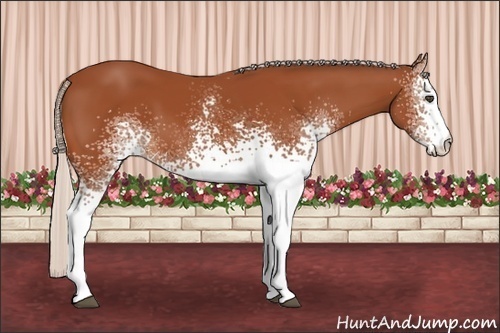
KC 473310De gustibus non disputandum. "There's no arguing about tastes."
SandyCreek Farm: ID# 441
also playing H&J1 as SandyCreek Acres: ID# 137592

















